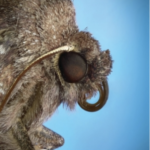News, Moth Patterned Lenses inspire Antireflective Coating
By adinagreene On March 4, 2020 · Leave a Comment · In 2020 SP Team 35, 2020 SP Week 05, Biol. Discoveries translated into devices
A new anti-reflective coating inspired by the compound lenses in moth eyes could help boost the efficiency of solar cells and sharpen the view of image sensors. Nature provides an alternative design strategy for an affordable, broadband antireflective coating. Nocturnal moths navigate under the dim light of the moon and stars thanks to eyes made of arrays of microsized lenses called ommatidia, which are further patterned with dome-shaped nanostructures.
Learn about our two Decals!
 Click here to find out more about our Fall Bioinspired Design Decal and our Spring Bioinspired Design in Action Decal – ALL MAJORS are welcome.
Click here to find out more about our Fall Bioinspired Design Decal and our Spring Bioinspired Design in Action Decal – ALL MAJORS are welcome.Berkeley BioDesign Community
 Click here to learn about the BioD: Bio-Inspired Design @ Berkeley student organization or here to signup for more info.
Click here to learn about the BioD: Bio-Inspired Design @ Berkeley student organization or here to signup for more info.Search
Student Login




I imagine that the neurological circuits underlying these processes are governed by both 2d spacing maps with their brains as…
to reduce the impact of car accidents, it may be possible to study the force diverting physics of cockroaches to…
you see this type of head-bobbing stability in many avian creatures related to pigeons like chickens. the head ability to…
not like they taught horses how to run! this is an example of convergent evolution where both sea creatures and…
The brain functions in a similar way with neuronal connections. our brains are able to utilize the multiplicity of connections…